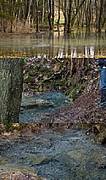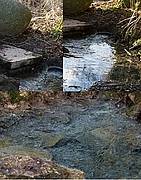Is there life on Mars ?
November 12 2014

Main spring area of the Sippenauer Moor

The cold, sulfidic spring of the Mühlbach Schwefelquelle Isling
An international research group will search for possible Mars analogue biotopes- in the region of Regensburg, Bavaria (02 December 2014).
Assessing life on Mars- if it ever was there- needs a basic knowledge of how life is capable to adapt to extreme environments. Interestingly, certain habitats on Mars reassemble regions on Earth and exhibit- on first sight- hostile environments for life.
Since the year 1939 the Sippenauer Moor is a unique protected marsh area near Kehlheim (Lower Bavaria, approximately 20km in the southeast of Regensburg) with several sulfidic and non-sulfidic spring outflows. The name "Sippenau" was earned due to an intensive sulphurous smell (the German word "sippen" means "to stink"). The 90.000m2 area crosses south of the river Danube in the "Feckinger Tal" between the location "Sippenau" and the connection of the streams "Feckinger Bach" and "Espenbach". The marsh rises out of the subsurface karst system, which has developed in the Jurassic carbonate setting. Since 1911 the botanical Society of Regensburg stands up for the extension of the protected area. Originally perfused by the Danube River, the south border of the Sippenauer Moor is supplied by sulfurous karstwaters and is characterized by deposits of the Upper Jurassic. In this region numerous karst water springs arise and provide the marsh with (mostly) sulfurous water.
The origin of sulfur has not been clarified yet; however a connection with lignite deposits or even pyrite deposits in the Upper Jurassic karst is speculated. Next to a tremendous variety of rare and highly specialized plant species (e.g. orchids and the originally presumed lost sundew) and animals, the marsh is inhabited by an enormous microbial diversity. The sampling in this study is going to take place in a main spring area with several spring outflows which combine to a small streamlet into a small lake. The aquifers are cold (10°C) throughout the year, rich in sulfide and ammonia and poor in organics.
The next cold sulfidic spring is situated in the district Burgweinting in Regensburg. The Mühlbach Schwefelquelle Isling is in contrast to the Sippenauer Moor an artificial spring which was drilled in the year 1925 in order to supply the city of Regensburg with fresh drinking water. Due to the strong smell of sulfur, the city of Regensburg decided to turn the spring into a nature reservoir instead. The drilled well has depth of 36.5m and a diameter of 18.5cm; at a depth of 23.45m the well reached an artesian groundwater table with a strong discharge and sulfuric odor.Similar to the Sippenauer Moor, cold, anaerobic (10°C) water, which is also almost free of organic compounds but rich in sulfur and ammonia reaches the surface.
Both sampling sites are easy to assess and sampling is permitted by the city of Regensburg and the botanical Society of Regensburg.

